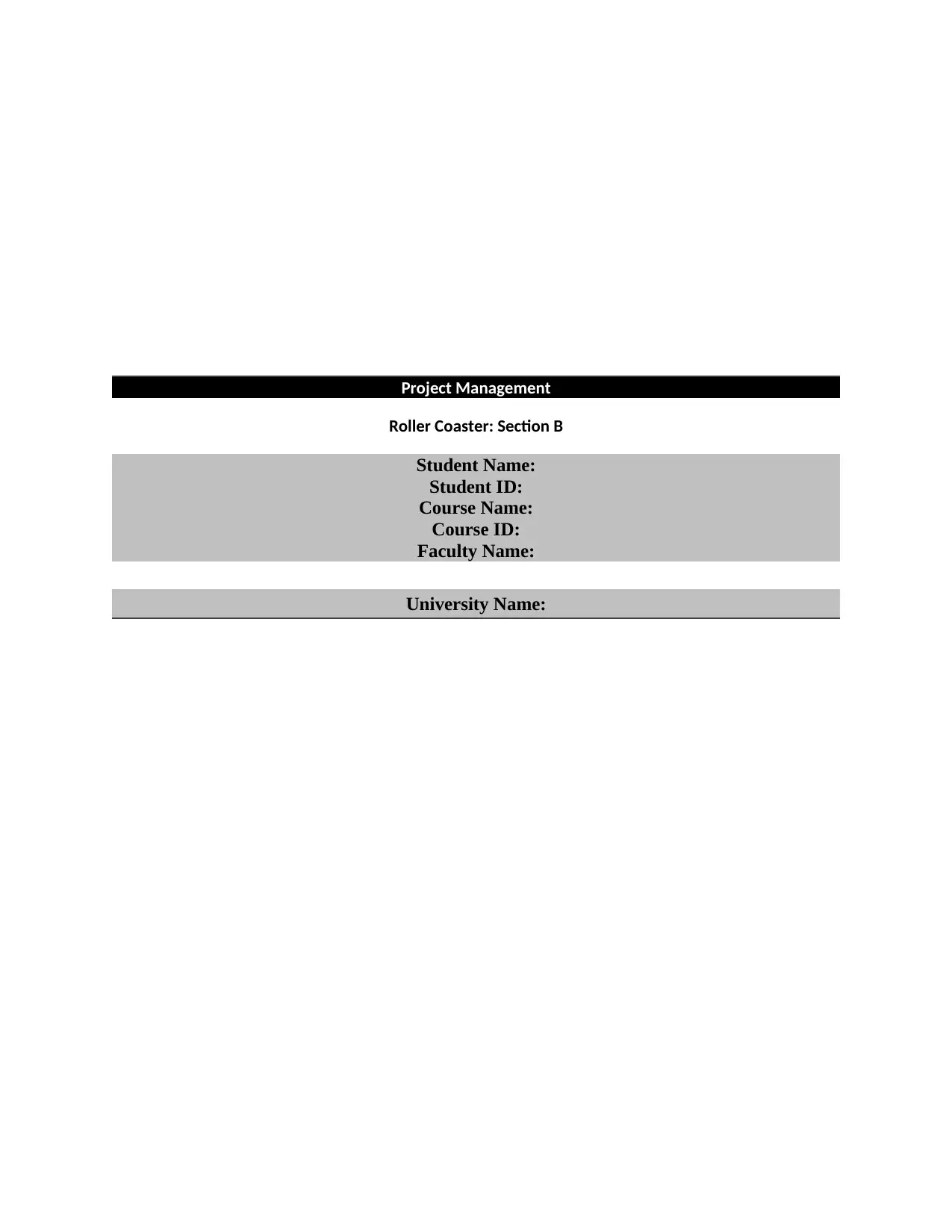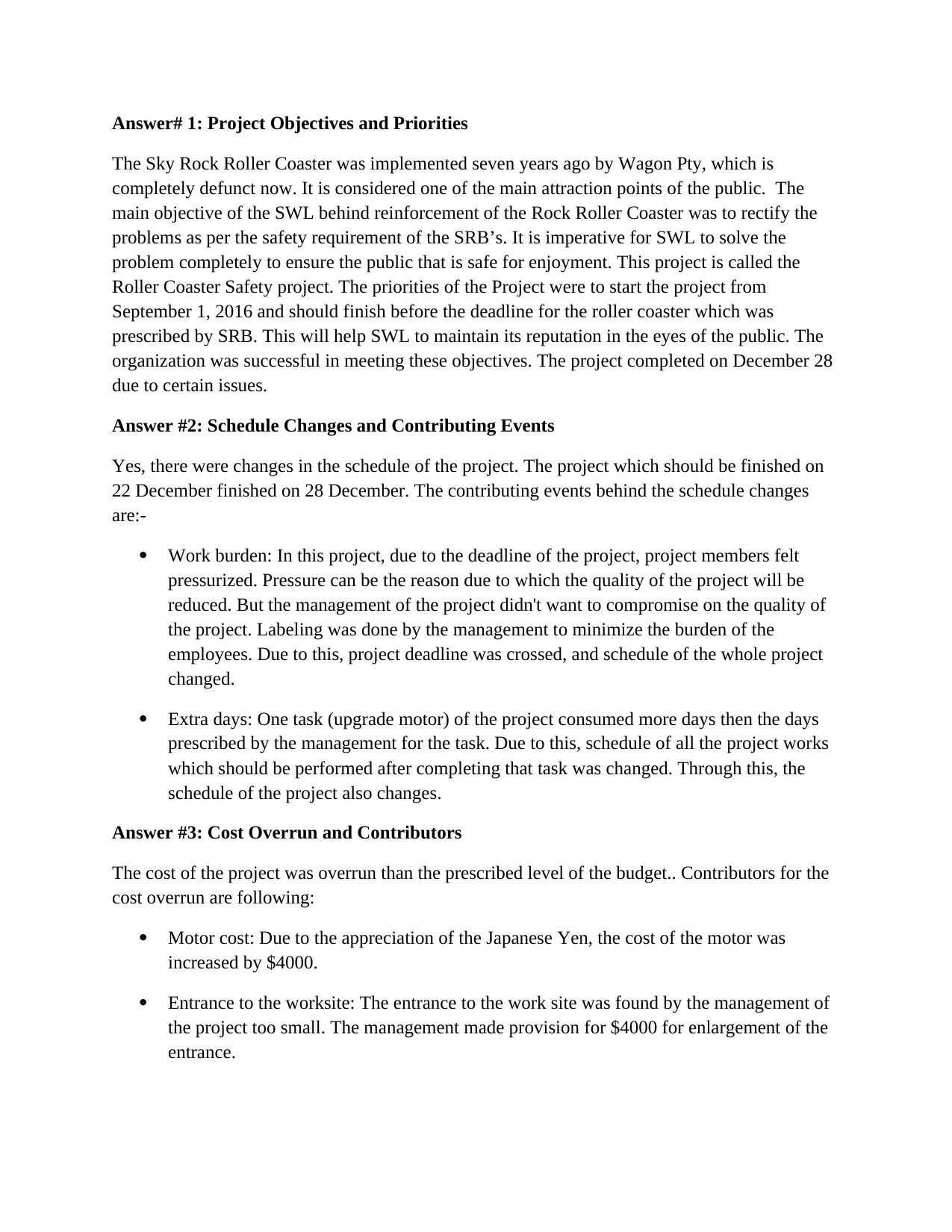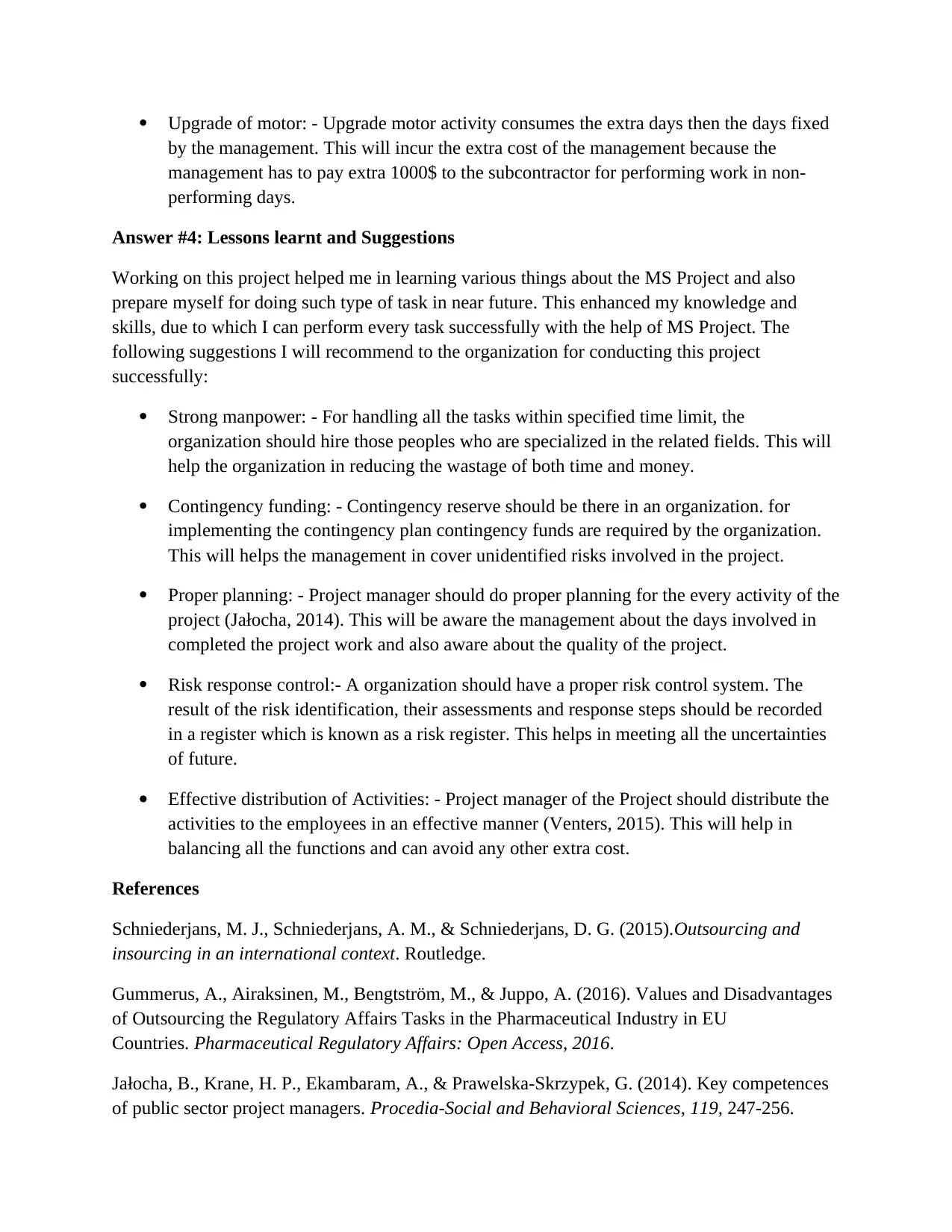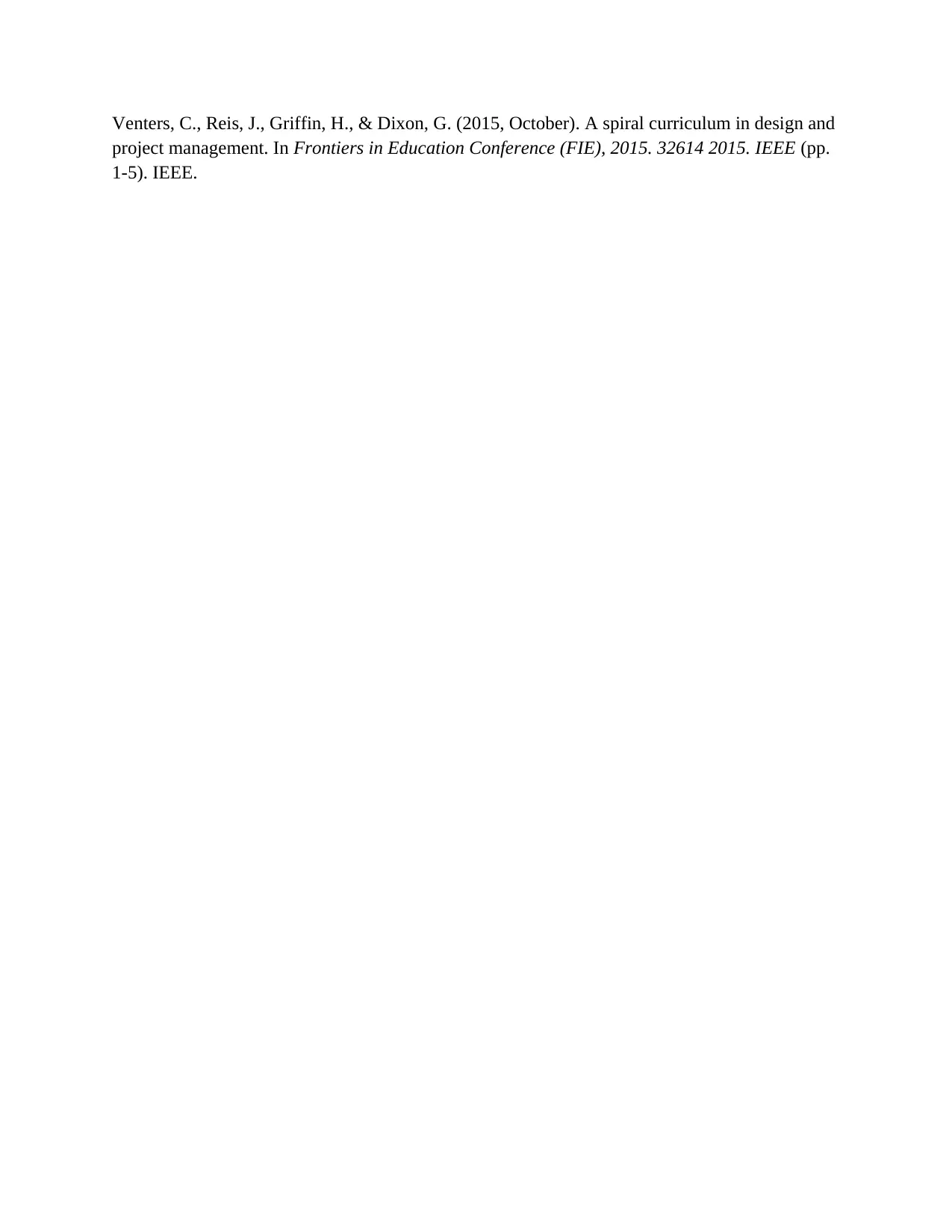Course ID: Project Management Roller Coaster Safety Project Report
VerifiedAdded on 2019/09/30
|4
|984
|161
Report
AI Summary
This report analyzes the Roller Coaster Safety Project, initiated by SWL to rectify safety issues of the Sky Rock Roller Coaster. The project's primary objective was to meet SRB safety requirements by a specified deadline, successfully achieving its goals despite schedule adjustments. The report details schedule changes due to work burden and extra task time, and cost overruns attributed to motor costs, worksite entrance modifications, and motor upgrade expenses. The author reflects on lessons learned, emphasizing the importance of strong manpower, contingency funding, proper planning, risk response control, and effective activity distribution. The report provides valuable insights into project management challenges and best practices, referencing relevant academic sources.

Project Management
Roller Coaster: Section B
Student Name:
Student ID:
Course Name:
Course ID:
Faculty Name:
University Name:
Roller Coaster: Section B
Student Name:
Student ID:
Course Name:
Course ID:
Faculty Name:
University Name:
Paraphrase This Document
Need a fresh take? Get an instant paraphrase of this document with our AI Paraphraser

Answer# 1: Project Objectives and Priorities
The Sky Rock Roller Coaster was implemented seven years ago by Wagon Pty, which is
completely defunct now. It is considered one of the main attraction points of the public. The
main objective of the SWL behind reinforcement of the Rock Roller Coaster was to rectify the
problems as per the safety requirement of the SRB’s. It is imperative for SWL to solve the
problem completely to ensure the public that is safe for enjoyment. This project is called the
Roller Coaster Safety project. The priorities of the Project were to start the project from
September 1, 2016 and should finish before the deadline for the roller coaster which was
prescribed by SRB. This will help SWL to maintain its reputation in the eyes of the public. The
organization was successful in meeting these objectives. The project completed on December 28
due to certain issues.
Answer #2: Schedule Changes and Contributing Events
Yes, there were changes in the schedule of the project. The project which should be finished on
22 December finished on 28 December. The contributing events behind the schedule changes
are:-
Work burden: In this project, due to the deadline of the project, project members felt
pressurized. Pressure can be the reason due to which the quality of the project will be
reduced. But the management of the project didn't want to compromise on the quality of
the project. Labeling was done by the management to minimize the burden of the
employees. Due to this, project deadline was crossed, and schedule of the whole project
changed.
Extra days: One task (upgrade motor) of the project consumed more days then the days
prescribed by the management for the task. Due to this, schedule of all the project works
which should be performed after completing that task was changed. Through this, the
schedule of the project also changes.
Answer #3: Cost Overrun and Contributors
The cost of the project was overrun than the prescribed level of the budget.. Contributors for the
cost overrun are following:
Motor cost: Due to the appreciation of the Japanese Yen, the cost of the motor was
increased by $4000.
Entrance to the worksite: The entrance to the work site was found by the management of
the project too small. The management made provision for $4000 for enlargement of the
entrance.
The Sky Rock Roller Coaster was implemented seven years ago by Wagon Pty, which is
completely defunct now. It is considered one of the main attraction points of the public. The
main objective of the SWL behind reinforcement of the Rock Roller Coaster was to rectify the
problems as per the safety requirement of the SRB’s. It is imperative for SWL to solve the
problem completely to ensure the public that is safe for enjoyment. This project is called the
Roller Coaster Safety project. The priorities of the Project were to start the project from
September 1, 2016 and should finish before the deadline for the roller coaster which was
prescribed by SRB. This will help SWL to maintain its reputation in the eyes of the public. The
organization was successful in meeting these objectives. The project completed on December 28
due to certain issues.
Answer #2: Schedule Changes and Contributing Events
Yes, there were changes in the schedule of the project. The project which should be finished on
22 December finished on 28 December. The contributing events behind the schedule changes
are:-
Work burden: In this project, due to the deadline of the project, project members felt
pressurized. Pressure can be the reason due to which the quality of the project will be
reduced. But the management of the project didn't want to compromise on the quality of
the project. Labeling was done by the management to minimize the burden of the
employees. Due to this, project deadline was crossed, and schedule of the whole project
changed.
Extra days: One task (upgrade motor) of the project consumed more days then the days
prescribed by the management for the task. Due to this, schedule of all the project works
which should be performed after completing that task was changed. Through this, the
schedule of the project also changes.
Answer #3: Cost Overrun and Contributors
The cost of the project was overrun than the prescribed level of the budget.. Contributors for the
cost overrun are following:
Motor cost: Due to the appreciation of the Japanese Yen, the cost of the motor was
increased by $4000.
Entrance to the worksite: The entrance to the work site was found by the management of
the project too small. The management made provision for $4000 for enlargement of the
entrance.

Upgrade of motor: - Upgrade motor activity consumes the extra days then the days fixed
by the management. This will incur the extra cost of the management because the
management has to pay extra 1000$ to the subcontractor for performing work in non-
performing days.
Answer #4: Lessons learnt and Suggestions
Working on this project helped me in learning various things about the MS Project and also
prepare myself for doing such type of task in near future. This enhanced my knowledge and
skills, due to which I can perform every task successfully with the help of MS Project. The
following suggestions I will recommend to the organization for conducting this project
successfully:
Strong manpower: - For handling all the tasks within specified time limit, the
organization should hire those peoples who are specialized in the related fields. This will
help the organization in reducing the wastage of both time and money.
Contingency funding: - Contingency reserve should be there in an organization. for
implementing the contingency plan contingency funds are required by the organization.
This will helps the management in cover unidentified risks involved in the project.
Proper planning: - Project manager should do proper planning for the every activity of the
project (Jałocha, 2014). This will be aware the management about the days involved in
completed the project work and also aware about the quality of the project.
Risk response control:- A organization should have a proper risk control system. The
result of the risk identification, their assessments and response steps should be recorded
in a register which is known as a risk register. This helps in meeting all the uncertainties
of future.
Effective distribution of Activities: - Project manager of the Project should distribute the
activities to the employees in an effective manner (Venters, 2015). This will help in
balancing all the functions and can avoid any other extra cost.
References
Schniederjans, M. J., Schniederjans, A. M., & Schniederjans, D. G. (2015).Outsourcing and
insourcing in an international context. Routledge.
Gummerus, A., Airaksinen, M., Bengtström, M., & Juppo, A. (2016). Values and Disadvantages
of Outsourcing the Regulatory Affairs Tasks in the Pharmaceutical Industry in EU
Countries. Pharmaceutical Regulatory Affairs: Open Access, 2016.
Jałocha, B., Krane, H. P., Ekambaram, A., & Prawelska-Skrzypek, G. (2014). Key competences
of public sector project managers. Procedia-Social and Behavioral Sciences, 119, 247-256.
by the management. This will incur the extra cost of the management because the
management has to pay extra 1000$ to the subcontractor for performing work in non-
performing days.
Answer #4: Lessons learnt and Suggestions
Working on this project helped me in learning various things about the MS Project and also
prepare myself for doing such type of task in near future. This enhanced my knowledge and
skills, due to which I can perform every task successfully with the help of MS Project. The
following suggestions I will recommend to the organization for conducting this project
successfully:
Strong manpower: - For handling all the tasks within specified time limit, the
organization should hire those peoples who are specialized in the related fields. This will
help the organization in reducing the wastage of both time and money.
Contingency funding: - Contingency reserve should be there in an organization. for
implementing the contingency plan contingency funds are required by the organization.
This will helps the management in cover unidentified risks involved in the project.
Proper planning: - Project manager should do proper planning for the every activity of the
project (Jałocha, 2014). This will be aware the management about the days involved in
completed the project work and also aware about the quality of the project.
Risk response control:- A organization should have a proper risk control system. The
result of the risk identification, their assessments and response steps should be recorded
in a register which is known as a risk register. This helps in meeting all the uncertainties
of future.
Effective distribution of Activities: - Project manager of the Project should distribute the
activities to the employees in an effective manner (Venters, 2015). This will help in
balancing all the functions and can avoid any other extra cost.
References
Schniederjans, M. J., Schniederjans, A. M., & Schniederjans, D. G. (2015).Outsourcing and
insourcing in an international context. Routledge.
Gummerus, A., Airaksinen, M., Bengtström, M., & Juppo, A. (2016). Values and Disadvantages
of Outsourcing the Regulatory Affairs Tasks in the Pharmaceutical Industry in EU
Countries. Pharmaceutical Regulatory Affairs: Open Access, 2016.
Jałocha, B., Krane, H. P., Ekambaram, A., & Prawelska-Skrzypek, G. (2014). Key competences
of public sector project managers. Procedia-Social and Behavioral Sciences, 119, 247-256.
⊘ This is a preview!⊘
Do you want full access?
Subscribe today to unlock all pages.

Trusted by 1+ million students worldwide

Venters, C., Reis, J., Griffin, H., & Dixon, G. (2015, October). A spiral curriculum in design and
project management. In Frontiers in Education Conference (FIE), 2015. 32614 2015. IEEE (pp.
1-5). IEEE.
project management. In Frontiers in Education Conference (FIE), 2015. 32614 2015. IEEE (pp.
1-5). IEEE.
1 out of 4
Related Documents
Your All-in-One AI-Powered Toolkit for Academic Success.
+13062052269
info@desklib.com
Available 24*7 on WhatsApp / Email
![[object Object]](/_next/static/media/star-bottom.7253800d.svg)
Unlock your academic potential
Copyright © 2020–2025 A2Z Services. All Rights Reserved. Developed and managed by ZUCOL.



